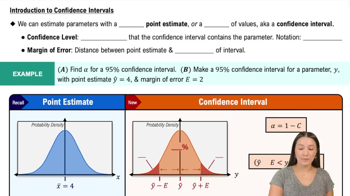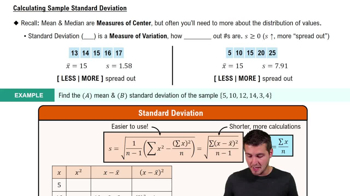Degrees of Freedom For Example 1, we used df=smaller of n1-1 and n2-1 we got df=11 and the corresponding critical value is t=-1.796 (found from Table A-4). If we calculate df using Formula 9-1, we get df=19.370 and the corresponding critical value is t=-1.727 How is using the critical value of t=-1.796 “more conservative” than using the critical value of t=-1.727
Table of contents
- 1. Intro to Stats and Collecting Data1h 14m
- 2. Describing Data with Tables and Graphs1h 55m
- 3. Describing Data Numerically2h 5m
- 4. Probability2h 16m
- 5. Binomial Distribution & Discrete Random Variables3h 6m
- 6. Normal Distribution and Continuous Random Variables2h 11m
- 7. Sampling Distributions & Confidence Intervals: Mean3h 23m
- Sampling Distribution of the Sample Mean and Central Limit Theorem19m
- Distribution of Sample Mean - Excel23m
- Introduction to Confidence Intervals15m
- Confidence Intervals for Population Mean1h 18m
- Determining the Minimum Sample Size Required12m
- Finding Probabilities and T Critical Values - Excel28m
- Confidence Intervals for Population Means - Excel25m
- 8. Sampling Distributions & Confidence Intervals: Proportion1h 12m
- 9. Hypothesis Testing for One Sample3h 29m
- 10. Hypothesis Testing for Two Samples4h 50m
- Two Proportions1h 13m
- Two Proportions Hypothesis Test - Excel28m
- Two Means - Unknown, Unequal Variance1h 3m
- Two Means - Unknown Variances Hypothesis Test - Excel12m
- Two Means - Unknown, Equal Variance15m
- Two Means - Unknown, Equal Variances Hypothesis Test - Excel9m
- Two Means - Known Variance12m
- Two Means - Sigma Known Hypothesis Test - Excel21m
- Two Means - Matched Pairs (Dependent Samples)42m
- Matched Pairs Hypothesis Test - Excel12m
- 11. Correlation1h 6m
- 12. Regression1h 50m
- 13. Chi-Square Tests & Goodness of Fit1h 57m
- 14. ANOVA1h 57m
7. Sampling Distributions & Confidence Intervals: Mean
Introduction to Confidence Intervals
Problem 7.3.22a
Textbook Question
Large Data Sets from Appendix B. In Exercises 21 and 22, use the data set in Appendix B. Assume that each sample is a simple random sample obtained from a population with a normal distribution.
Birth Weights Refer to Data Set 6 “Births” in Appendix B.
a. Use the 205 birth weights of girls to construct a 95% confidence interval estimate of the standard deviation of the population from which the sample was obtained.
 Verified step by step guidance
Verified step by step guidance1
Step 1: Understand the problem. You are tasked with constructing a 95% confidence interval for the standard deviation of the population using the sample of 205 birth weights of girls. This involves using the chi-square distribution, as confidence intervals for population variance or standard deviation are based on this distribution.
Step 2: Identify the formula for the confidence interval of the population variance. The formula is: \( \left( \frac{(n-1)s^2}{\chi^2_{\text{upper}}}, \frac{(n-1)s^2}{\chi^2_{\text{lower}}} \right) \), where \( n \) is the sample size, \( s^2 \) is the sample variance, and \( \chi^2_{\text{upper}} \) and \( \chi^2_{\text{lower}} \) are the critical values of the chi-square distribution corresponding to the desired confidence level.
Step 3: Calculate the sample variance \( s^2 \) using the birth weights data. The formula for variance is \( s^2 = \frac{\sum (x_i - \bar{x})^2}{n-1} \), where \( x_i \) are the individual data points, \( \bar{x} \) is the sample mean, and \( n \) is the sample size. Compute \( s^2 \) using the provided data set.
Step 4: Determine the critical values \( \chi^2_{\text{upper}} \) and \( \chi^2_{\text{lower}} \) for the chi-square distribution. Use the degrees of freedom \( df = n-1 \) and the confidence level (95%) to find these values from a chi-square table or statistical software. The critical values correspond to the upper and lower tails of the distribution.
Step 5: Plug the values into the formula for the confidence interval of the variance. Once the confidence interval for the variance is calculated, take the square root of both bounds to obtain the confidence interval for the standard deviation. The final interval will provide the range within which the population standard deviation is likely to fall with 95% confidence.
 Verified video answer for a similar problem:
Verified video answer for a similar problem:This video solution was recommended by our tutors as helpful for the problem above
Video duration:
5mPlay a video:
Was this helpful?
Key Concepts
Here are the essential concepts you must grasp in order to answer the question correctly.
Confidence Interval
A confidence interval is a range of values, derived from a data set, that is likely to contain the true population parameter with a specified level of confidence, typically expressed as a percentage. For example, a 95% confidence interval suggests that if we were to take many samples and construct intervals in the same way, approximately 95% of those intervals would contain the true population parameter.
Recommended video:

Introduction to Confidence Intervals
Standard Deviation
Standard deviation is a measure of the amount of variation or dispersion in a set of values. In the context of a population, it quantifies how much individual data points deviate from the mean. A smaller standard deviation indicates that the data points tend to be closer to the mean, while a larger standard deviation indicates more spread out values.
Recommended video:
Guided course

Calculating Standard Deviation
Simple Random Sample
A simple random sample is a subset of individuals chosen from a larger population, where each individual has an equal chance of being selected. This method helps ensure that the sample is representative of the population, reducing bias and allowing for valid statistical inferences about the population based on the sample data.
Recommended video:

Sampling Distribution of Sample Proportion

 6:33m
6:33mWatch next
Master Introduction to Confidence Intervals with a bite sized video explanation from Patrick
Start learningRelated Videos
Related Practice
Textbook Question
